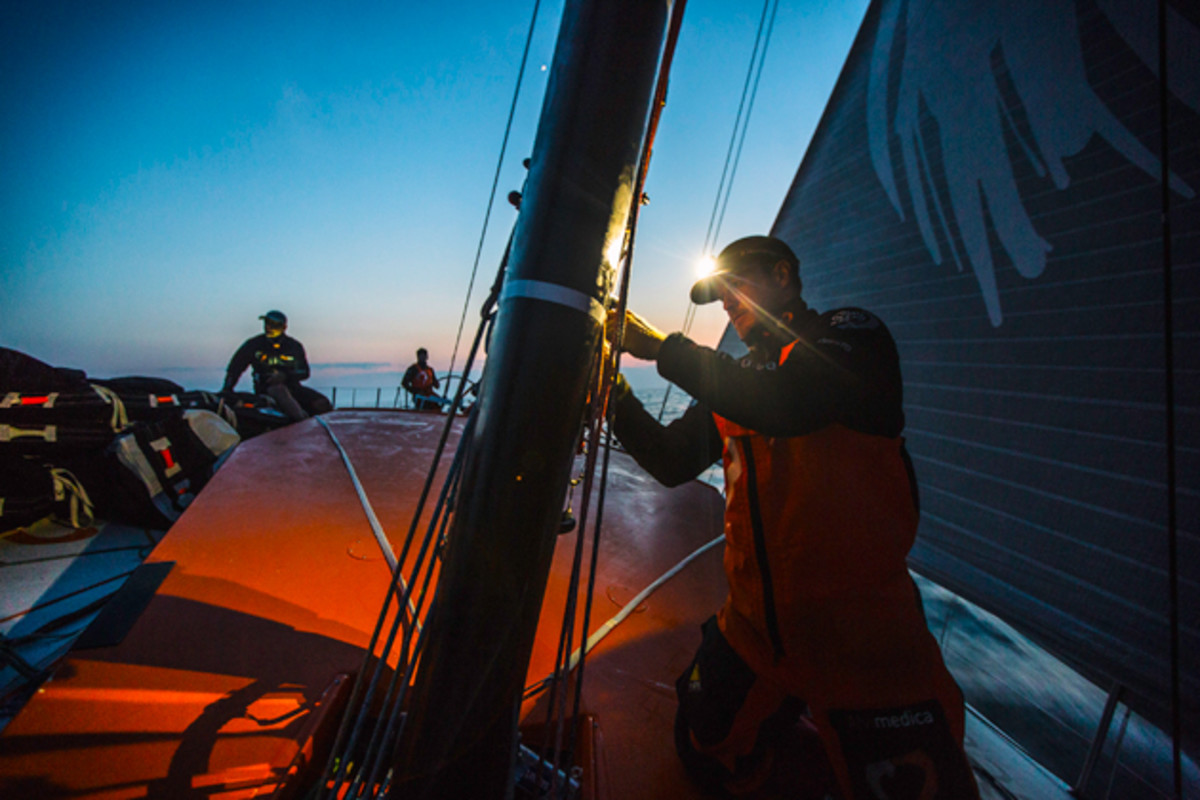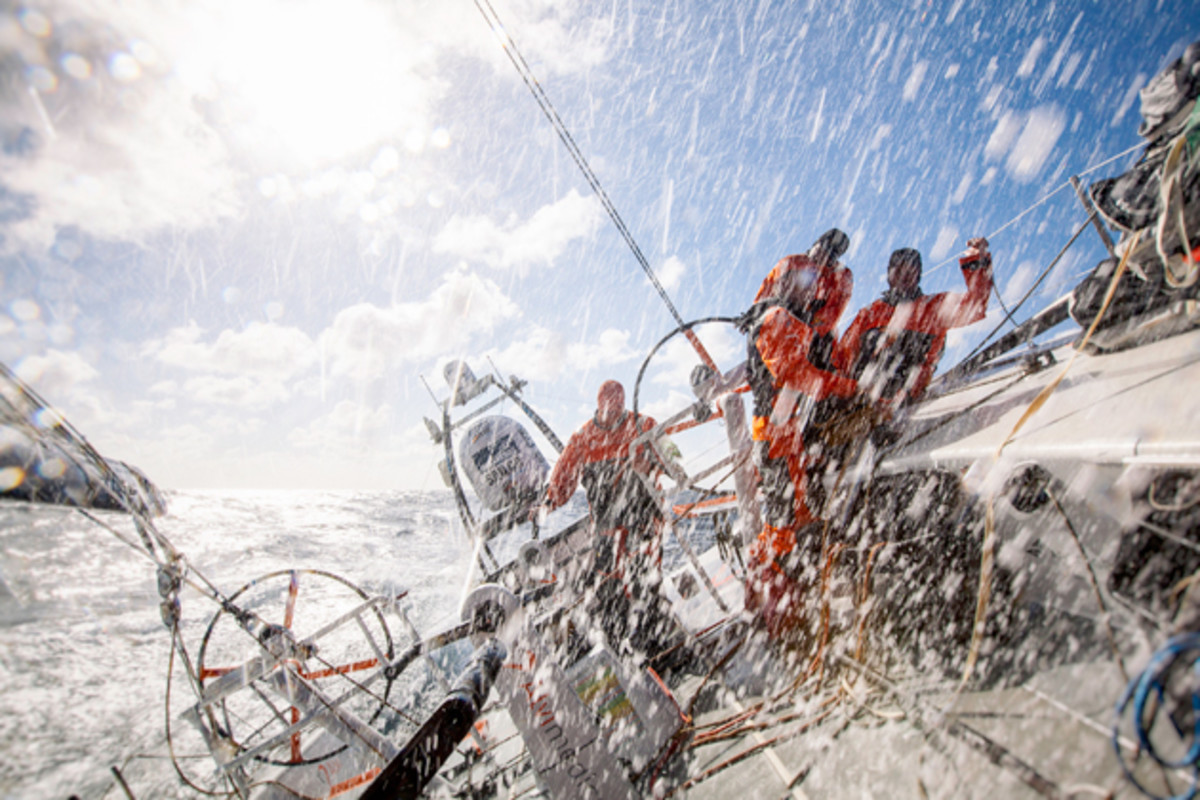Volvo Ocean Race: Rigor, risk and reward in a race across the Atlantic

Six legs down, three to go.
The longest remaining leg—and potentially the most treacherous—of the nine-month, 38,739-nautical mile Volvo Ocean Race is under way, with the six remaining yachts departing Newport, R.I., on Sunday, and sailng east across the North Atlantic toward Lisbon.
“The transatlantic can really be anything,” said Team Alvimedica skipper Charlie Enright, a Rhode Island native, during last week’s sole United States stopover. “You have to expect the unexpected more so than any other leg. There are dominant weather features that are going to govern how this leg is going to play out. It can have the makings of the worst leg of the race, or it can be fairly benign. It's tough to tell.”
Britain’s Ian Walker, skipper of the Abu Dhabi Ocean Racing yacht and the current race leader, concurred that unpredictable was the watchword for the crossing.
“There’s going to be some fast reaching, and you’ve always got the Gulf Stream as well,” said Walker. “The Gulf Stream has a chance to decide this thing, as it did in the last race. The conditions can be pretty bad. You can have strong winds against current in the Gulf Stream, and there can be some very difficult decisions to be made whether you’re ready to take that on or not.”
Volvo Ocean Race: High-tech, high-stakes and high seas
Later, during a practice race, Walker was even more candid, and foreboding.
“We’re going to have gale force winds from the Gulf Stream for a 200-mile section of the course,” he said. “Those conditions will be worse than anything we’ve seen in the race. I don’t think anyone appreciates how bad it’s going to be, because they’ve not been there and seen it. I have, and it’s going to be a real test.”
At 2,800 nautical miles (or 3,222 statute miles), the North Atlantic leg is one that team skippers clearly respect. While the mood during the Newport stopover was fairly lighthearted, it changed noticeably when the talk turned to the crossing.
“We all know that the guys here are going to treat this leg as a sprint,” said England’s Sam Davies, skipper of the all-female crew aboard Team SCA.
“I’ve got bad news for Sam,” replied Walker. “This isn’t a sprint. We’re crossing the Atlantic. It’s a long way. I’m not going to stay up for nine days.”
Asked what his main concerns with the leg were, Dongfeng Race Team captain Charles Caudrelier of France gave a wry smile and said, simply: “To finish it. And not break anything.”
Caudrelier, whose yacht currently sits in second place, was not alone in his assessment.

“The leg is very risky for all of us,” said Iker Martínez of Spain, the Team MAPFRE skipper. “It is tough, difficult and dangerous.”
Martínez knows firsthand. He has bitter memories of the crossing from the 2012 Volvo race, when his Telefónica yacht faltered, allowing Groupama to win the overall title.
“Last time on this leg, we break down,” said Martínez. “So, yes, we know that. We always face the North Atlantic making sure we are all prepared and to be careful. It’s a place that can be difficult and dangerous, but it is a special leg."
Martínez’s 2012 disappointment pales in comparison to the fateful 2006 crossing of Team ABN Amro, when 32-year-old Hans Horrevoets of the Netherlands drowned sea after being swept overboard.
“Hans was a very good friend of mine,” said Team Brunel skipper Bouwe Bekking of the Netherlands. “If you just look at history in this next leg, lots of rigs have been broken, a boat has sunk, a person has lost his life and we know we’re going to Europe. So people just push so hard on this leg.”
The timing of the transatlantic also fuels a heightened sense of anxiety, since it is the last “major” stretch before two short finishing legs in Europe.
CRASH-B's: The high and the hell of indoor rowing
“As the race goes on, people’s objectives sometimes change,” said Walker. “People are desperate for a leg win, or more looking at the overall standings. So there’s the potential for people to take more risks than they would have earlier in the race.”
However, Bekking, who lost his yacht during the same leg in the 2005-06 race, also pointed out that the one-design Volvo 65, though not the fastest of yachts, has proven to be seaworthy. Of the seven yachts that left Alicante, Spain, at the race start in October, only Team Vestas Wind was eliminated mid-race, after running aground on the Cargados Carajos Shoals in the Indian Ocean. According to race observers, that crash was the result of navigation error, not any fault of the boat.
“The boats and the equipment in previous [Volvo] races probably weren’t maintained as well, and people were running out of budget,” said Bekking. “This time, all the boats are superbly prepared, and we all have good equipment. Hopefully, we don't get any breakages.”
That factor may prove a turning point not only for the current Volvo Ocean Race, but future editions of this circumnavigation competition (held every three years) as well. The identical $6 million Volvo 65 yachts, designed by Farr Yacht Design in the U.S. and built by a consortium of boatyards in Europe, are clearly slower than their predecessor, the Volvo 70. In fact, Walker compared the new yacht to a Volvo 70 with “training wheels,” even while acknowledging that the older boat was prone to breakdowns.
Conversely, the 27,500-pound Volvo 65s are “much stiffer, stronger, safer,” he said. “And, like anything, the reason we used to take all the weight out of the boats was it made you go faster. So you can’t have it both ways.”

Still, the future of the Volvo Ocean Race, which started in 1973 as the Whitbread Round the World Race, literally hung in the balance prior to the decision to approve the one-design and shared services concepts (a Providence Journal reporter compared those “shared services” to an Indianapolis 500 in which all the race cars were serviced by the same pit crew).
Those decisions “fundamentally changed the race,” said Walker, because they not only leveled the playing field—ensuring that results were determined strictly on sailing skill, not on any design advantage—but also capped the cost for sponsors. That gave sponsors some financial certainty, and the knowledge that no team was unfairly handicapped right from the start.
“Let’s be clear—there wouldn’t have been a [2014-15] race if they didn’t change the rules,” said Walker. “The whole discussion about whether it’s a good thing or not is actually futile, because there’s no way they would have had six or seven teams with the budget in place in time to build a Volvo 70 for this race.
“Of course, the guys who had the fast boats, and were winning everything, they didn’t want one-design. So I guess it does depend whether you prefer the technical side of the sport, or if you like the racing and human side of the sport. And I’ve always [preferred] the latter.”
Still, no matter how safe the boats, they are still 65-foot yachts, with a crew of eight (or 11 for Team SCA), battling all the elements that Mother Nature can bring to bear in open waters. That, said the captains, makes ocean racing one of the last great adventures on the planet.
“A lot of people can sail around the world,” said Vestas Wind skipper Chris Nicholson of Australia. “The real difficulty comes into place when you’ve got the best of teams competing against one another. That’s when more of the adventure comes into this. At the end of the day, it’s a privilege to be able to compete in this race.”
Abu Dhabi skipper Walker admitted the very real dangers of racing 24/7 occasionally keep him awake. Especially at night.
“I still stop myself every now and then when we’re hurtling along at 20 knots in the middle of the night and I think to myself, ‘This is insane.’ You wouldn't drive a car with the lights off, not knowing where you’re going,” he said. “You’re basically playing a game of Russian roulette.
“It’s only a matter of time before you hit something you can’t see. You just have to rely on the percentages. And the odds are pretty good in your favor.”
